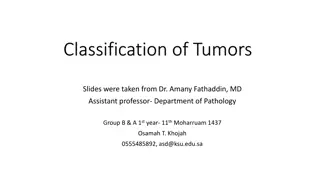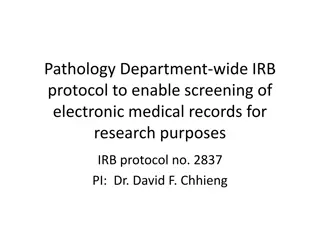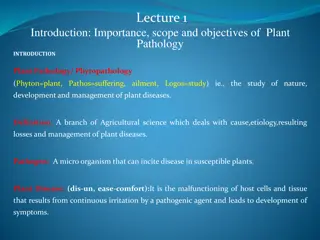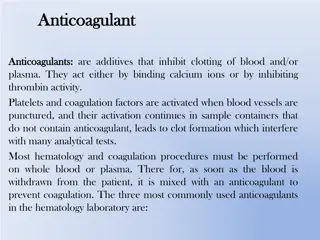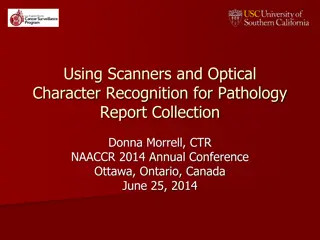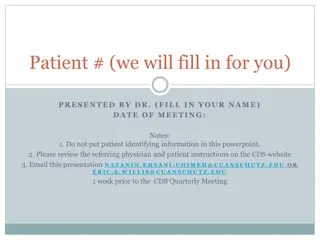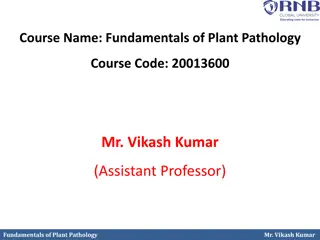Overview of Veterinary Clinical Pathology and Importance of Anticoagulants
Veterinary clinical pathology involves the laboratory diagnostics and analysis of bodily fluids and tissues to support the diagnosis, treatment, and prevention of diseases. This field encompasses interpreting blood tests, blood smear examinations, and the use of various anticoagulants in specimen collection. Common anticoagulants used in clinical pathology include EDTA, sodium citrate, heparin, sodium oxalate, and more. Understanding the types of specimens and anticoagulants used is crucial for accurate diagnosis and management of veterinary patients.
Download Presentation

Please find below an Image/Link to download the presentation.
The content on the website is provided AS IS for your information and personal use only. It may not be sold, licensed, or shared on other websites without obtaining consent from the author.If you encounter any issues during the download, it is possible that the publisher has removed the file from their server.
You are allowed to download the files provided on this website for personal or commercial use, subject to the condition that they are used lawfully. All files are the property of their respective owners.
The content on the website is provided AS IS for your information and personal use only. It may not be sold, licensed, or shared on other websites without obtaining consent from the author.
E N D
Presentation Transcript
Veterinary Clinical Pathology Dr. Kaushal Kumar Assistant Professor and Head Department of Veterinary pathology Bihar Veterinary College, Bihar Animal Sciences University, Patna, Bihar
Topics Different Anticoagulants used in Haematology A Interpretation of blood test/ Haematology B Blood smear examination and its interpretation C
What is clinical pathology? It covers a wide range of laboratory functions and is concerned treatment, and prevention of disease. with the diagnosis, It supports the diagnosis of disease using laboratory testing of blood and other bodily fluids, tissues, and microscopic evaluation of individual cells.
Importance/Role of Clinical Pathology No wonder that drug is a wonder than diagnosis of a doctor
Types of specimens used in clinical pathology Blood (Blood is used in many tests. Blood can either be examined as a "whole," as plasma (the fluid left when red and white blood cells are removed), or as serum (a clear fluid that separates from blood when it clots). Urine Sputum/phlegm Faeces Other body fluids (like plural fuid, bone marrow spinal fluid, joint fluid, Rumenal fluid etc)
Anticoagulant (An agent that is used to prevent the formation of blood clots) The common anticoagulants used are 1. Ethylenediamine tetra acetic acid ( Na or K salt of EDTA), 2. sodium citrate and 3. heparin. 4. Sodium oxalate 5. Potassium oxalate 6. CPD (citrate phosphate dextrose) /ACD (acid citrate dextrose ) solution 7. Sodium fluoride and thymol (10:1)
Recommended for routine hematology. It prevents blood from clotting by binding or chelating (binding) the calcium ions from the blood (calcium ions are necessary for blood to clot). Blood collected into EDTA is used for routine haematology tests. Amount required: 10mg for 10ml blood EDTA It is used to collect blood for coagulation studies. Samples must be gently mixed immediately after collection. Trisodium citrate chelates calcium ions from the blood (calcium ions are necessary for clotting). Amount required: 10mg for 10ml blood Trisodium citrate A poor anticoagulant for blood cell studies.(may cause leukocyte clumping and interfere its stainability ) Used for some specialized blood biochemistry and blood pH studies. Heparin prevents blood coagulation by inhibiting the action of thrombin. Thrombin is an activated coagulation protein that converts fibrinogen to fibrin. Amount required: 1-2 mg (0.2ml of 1%soln) for 10ml blood Heparin
Haematology It is the study of the cells and proteins found in blood. A complete blood count consists of the following tests: Hemoglobin determination Hematocrit /PCV reading Total Erytherocyte count Erytherocytic indices Erytherocytic Sedimentation Rate Total leukocyte count Differential leukocyte count
Hematological tests General consideration / Principle of test Methods Interpretation
HEMOGLOBIN DETERMINATION or Hemoglobinometry It is the measurement of the concentration of hemoglobin in the blood Measured in gm/dl of blood Methods are 1. Cyanmethemoglobin (automated )method 2. Acid Hematin Method(Haden-Hausse and Sahli-Hellige methods )
HEMOGLOBIN DETERMINATION by Cyanmethemoglobin method This procedure is based on the oxidation of hemoglobin and formation of methemoglobin in the presence of alkaline potassium ferricyanide. Methemoglobin reacts with potassium cyanide to form cyanmethemoglobin, which has maximum absorption at 540 nm. The color intensity measured at 540 nm is proportional to the concentration. total hemoglobin
HEMOGLOBIN DETERMINATION by cyanmethemoglobin method Hb+ ferricyanide metheoglobin Cyanide ions Cyanmethemoglobin Stable red compound Measured calorimetrically Intensity is directly proportional to amount of Hb in the sample
Steps of cyanmethemoglobin method 1. Place 5 ml of Drabkin solution in a test tube 2. Get 0.02ml of blood in shalis pipette 3. Place it in Drabkin reagent through rinsing it 4. Mix and let it stand for 8-10 min 5. Read in spectrophotometer at 540 nm Drabkin's reagent: sodium bicarbonate ( alkaline ), potassium ferricyanide, and potassium cyanide
HEMOGLOBIN DETERMINATION By Haden-Hausse /Sahli-Hellige methods Principle: Blood is mixed with dilute (N/10) hydrochloric acid. This process hemolyzes the red cells, disrupting the integrity of the red cells membrane and causing the release of hemoglobin, which, in turn, is converted to a brownish-colored solution of acid hematin. The acid hematin solution is then compared with a color standard.
Interpretation of Hb detrmination Hemoglobin values are affected by Age, Sex, Pregnancy, Disease, and Altitude. Below-normal hemoglobin values: During pregnancy, gains in body fluids cause the red cells to become less concentrated, causing the red cell count to fall. Since hemoglobin is contained in red cells, the hemoglobin concentration also falls. Disease may also affect the values of hemoglobin. For example, iron deficiency anemia may drop hemoglobin values from a normal value of 14 grams per 100 milliliters to 7 grams per 100 milliliters. Above-normal hemoglobin values: may occur when dehydration develops. Changes in altitude affect the oxygen content of the air and, therefore, also affect hemoglobin values. At higher altitudes there is less oxygen in the air, resulting in an increase in red cell counts and hemoglobin values. At lower altitudes there is more oxygen, resulting in a decrease in red cell counts and hemoglobin values. Normal range for haemoglobin determinations are as follows: Dog :12-18gm/dl Cattle :10-15gm/dl
Packed cell volume(Hematocrit) The hematocrit or packed cell volume (PCV) determines the percentage of red blood cells (RBCs) in whole blood. Two Methods: 1. Wintrobe method 2. Microhematocrit method Both methods call for the blood to be centrifuged, and the percentage of packed red cells is found by calculation
Equipment required for PCV estimation Wintrobe method Microhematocrit method Centrifuge Machine Wintrobe tube Special Wintrobe tube pipette Microhaematocrit Centrifuge Machine Microhematocrit reader Plane capillary tube
Methods for PCV determination Use a suitable centrifuge at an rpm that could provide a sufficient centrifugal force adequate to provide maximum packaging Wintrobe method 3000-4000 rpm for 30 min(dog and Horses) for 60 min(cattle ,pig,sheep,goat) Microhematocrit method 10,000-13,000 rpm for 5 min for all 15,000-16,000 rpm for 2 min for all
Interpretation of PCV The normal hematocrit value Dog is 45(40% to 52%); Cattle35(24% to 47%); Below normal- medical conditions such as anemia and leukemia may be present. Above-normal- hematocrit indicate medical conditions like dehydration, such as occur in severe burn cases. Haemoconcentration in fasting and some cachectic diseases condition. It is inadvisable to interpret the PCV of young animal by using adult normal range. determinations
Interpretation of PCV Age influences the normal PCV range Dog Age PCV 3week 32% 2-4 month- 32-45% 4-6month- 35-52% 6-8 month 41-55% As pup starts to ingest solid food PCV begins to increase Cattel Age PCV Hb Birth 42 15 2 month 35 11 24 month 32 10 PCV and Hb are higher at birth but are reduced as soon as the calf begins to nurse(input of iron is low in diet)
Erytherocyte Sedimentation Rate Ubiquitously used technique in medicine as a marker of systemic illness. Principle: The placing anticoagulated whole blood into an upright test tube and monitoring the rate at which red blood cells (RBC) fall over time and measured millimeters. test involves in
ESR-Principle Plasma fibrinogen) adhere to the RBC membrane and nutralizes the surface negative promoting cell adherence and rouleaux formation. ESR is directly proportional to Wt. of a cell aggregate. & indirectly proportional to surface area protein (especially charges
Methods Of ESR estimation (It uses the same wintrobe hematocrit tube (previously used for PCV)and the numbers on left of the scale down 0 to10cm is used. And it is possible to correct the ESR according to a correction chart developed by Landsberg). 1. Wintrobe Method wintrobe and 2.Westergren Method (most commonly used method of performing the ESR) westergren tube: Total length-300mm Diameter -2mm Capacity-1ml Graduation-0to200at1mm interval
Interpretation of ESR Normal ESR Value: Horses: 50(25-60)mm at 30min Dog: 15(8-25)mm at 1 Hr Cattle: 2(2-4)mm at 24Hr Tendency for rouleaux formation varies tremendously among different species- Horses- Intense rouleaux formation Dog/cat- moderatly Ruminants-Absent in health Non specific test for inflammatory processes. It is used as monitoring tools for response to treatment in condition in which it is raised (TB,AID)
Interpretation of ESR Used extensively in human medicine and canine practice. It is not diagnostic of any one disease. Serves as guide to prognosis Normal ESR value doesn`t exclude the possibilities of diseases process. General condition where ESR increases- Infections Skin infection Tissue injury, Malignant tumour Pregnancy(Anaemia,cholesterolemia & increased Fibrinogen Negative ESR Lowplasma protein Concentration Liver diseases Poor Nutrition
When a patient has a lower it is important to determine whether red blood cells are of normal size and if they have a normal concentration of hemoglobin. These measurements, known as erythrocyte erythrocyte or red red blood important information about various types of anemias. lower than than normal normal hemoglobin, hemoglobin, blood cell cell indices indices, provide
Erythrocyte or red blood cell indices Measures the mean or average size of individual red blood cells. To obtain the MCV, the hematocrit is divided by the total RBC count. The results are reported in femoliters (fl) Mean corpuscular volume (MCV) Measures the amount, or the mass, of hemoglobin present in one RBC. It is obtained by dividing the hemoglobin by the total RBC count. The results are reported in picogram (pg) Mean corpuscular hemoglobin (MCH) Mean corpuscular hemoglobin concentration (MCHC) Measures the proportion of hemoglobin in the RBC in percentage. The hemoglobin is divided by the hematocrit and multiplied by 100 to obtain the MCHC. The results are reported in percentages(%)
Interpretation of erytherocytic indices Normal values for erythrocyte indices of a healthy Dog are: MCV values are higher in newborns and infants 80-98 fl (femoliters) MCH -:17-31 pg (picograms) MCHC: 32-36% Abnormal erthryocyte indices are helpful to classify types of anemia. Normal MCV, MCH and MCHC --- normocytic, normochromic anemia --- most often caused by acute blood loss Decreased MCV, MCH, and MCHC --- microcytic, hypochromic anemia --- most often caused by iron deficiency Increased MCV, variable MCH and MCHC --- macrocytic anemia most often caused by Vitamin B12 deficiency (due to pernicious anemia) and folic acid deficiency
COUNTING BLOOD CELLS you will need A Microscope with light source and an instrument called a Hemacytometer with coverglass. Free AP image
Loading the counting chamber. After discarding the first 3 drops, load (charge) the counting chamber of the hemacytometer by gently touching the tip of the pipette against the edge of the cover glass and the surface of the counting chamber & Allow 3 minutes for cells to settle
LOADING HEMACYTOMETER: A. Hemacytometer properly loaded; B. Hemacytometer improperly loaded.
Calculation of Cell Counting TEC TLC The sum of the cells counted in the 5 small square X 10,000 = total Erytherocyte / microliter The sum of the cells counted in the 4 Corner square X 50 = total Leukocyte / microliter
Interpretation of TEC The TEC is elevated in Hemoconcentration & dehydration Stress High altitude Cardiovascular Diseases The TEC is decreased in Anaemia Hemoolysis CRF Haemorrhage Failure of bone marrpow production NOTE: TEC is a part of CBC and is must be used along with Hb Conc. And Haemtocrit to determine if a patient has anamia, polycythemia, dehydration , or response to treatment related to those conditions. RBC usually rises or falls along with Hb or hematocrit.
TWO measurements of white blood cells are commonly done in a CBC 1. The total number of white blood cells in a microliter (1x10-9 liters) of blood, reported as an absolute number of "X" thousands of white blood cells, and 2. The percentageof each of the five types of white blood cells. This test is known as a differential or "diff" and is reported in percentages.
Interpretation of TLC & DLC Normal values for total WBC and differential in adult DOG are: Total WBC: 10,000 - 12,000 per cubic millimeter Bands or stabs: 3 - 5 % Differential count : WBC Relative Value Absolute Value Neutrophils 60-75 6000-7500 Eosinophils 2-10 200-1000 Basophils 0-2 0-200 Lymphocytes 10-30 1000-3000 Moncytes 2-12 200-1200 To make an accurate assessment, consider both relative and absolute values. For example a relative value of 70% neutrophils may seem within normal limits; however, if the total WBC is 20,000, the absolute value (70% x 20,000) would be an abnormally high count of 14,000.
Instant Feedback: It is important to consider both the relative and absolute values of various types of white blood cells when interpreting a WBC differential count True False
Interpretation of TLC & DLC Leukocytosis- (due to an increase in one of the five types ) Neutrophilic leukocytosis = neutrophilia Lymphocytic leukocytosis = lymphocytosis Eosinophilic leukocytosis = eosinophilia Monocytic leukocytosis = monocytosis Basophilic leukocytosis = basophilia The numbers of leukocytes changes with age and during pregnancy 1. In response to an acute infection, trauma, or inflammation, white blood cells release a substance called colony-stimulating factor (CSF). 2. leukocytosis of a temporary nature, must be differentiated from leukemia, where the leukocytosis is both permanent and progressive. 3. Therapy with steroids modifies the leukocytosis response.
Instant Feedback: Corticosteroids can mask infection by suppressing the inflammatory response and the release of WBCs. True False
Leukopenia occurs when the WBC falls below 5,000. Viral infections, overwhelming bacterial infections, Protozoan infection and bone marrow disorders can all cause. Leukocytes: critical low and high values A WBC of less than 500 places the patient at risk for a fatal infection. A WBC over 30,000 indicates massive infection or a serious disease such as leukemia.
Differential Leukocyte Count One must be able to identify the different types of white blood cells This knowledge can be gained only by extensive, supervised practice
To perform a differential count, The following materials are required: 1. Plain glass microscope slides, clean and dry 2. Wright-Giemsa stain solution 3. Staining containers 4. Deionized or distilled water 5. Microscope with light source 6. Immersion oil 7. Blood cell counter Differential Count Procedure DLC is done in 4 steps: 1. Make the blood smear 2. Stain the cells 3. Count the cells 4. Report the count
Interpretation of TLC & DLC WBC Some general interpretations A severe infection with a good response of the bone marrow. The greater the shift to the left (increase in immature neutrophils), the more severe the infection Neutrophils Eosinophils in parasitic infections and allergic conditions Basophils Non-significant; sometimes assoc. with eosinophilia Lymphocytes indicates healing Moncytes indicates activity in the infected area, In case of tuberculosis The percentage of eosinophils, lymphocytes, and monocytes generally decreases in acute infections



